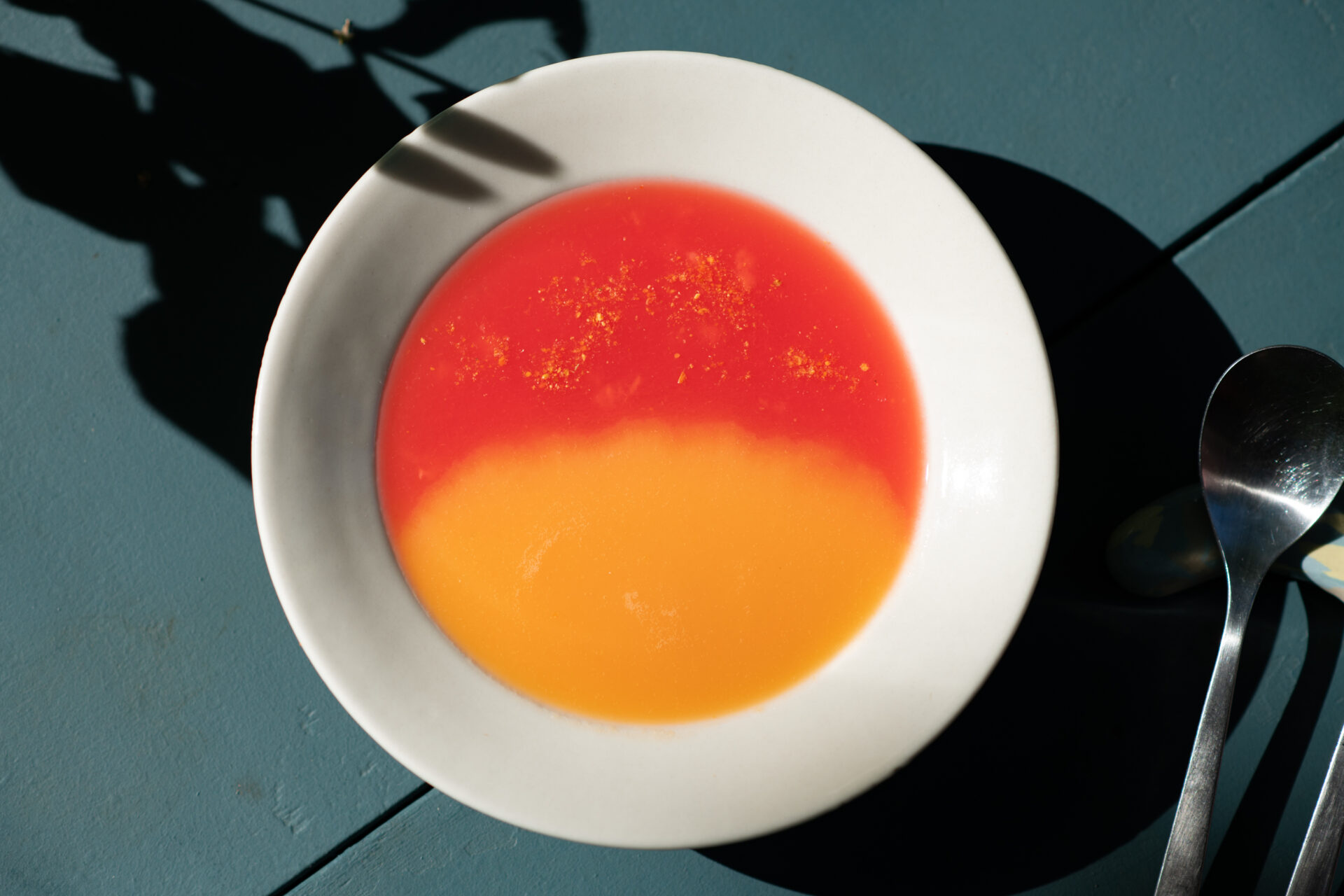On that day, the soup special featured watermelon and melon produced in Biei, Hokkaido. The dish was presented like a painting, brightly colored with the melon’s gentle orange and the watermelon’s vivid vermilion colors.
The soup looked like a wheat field before harvest, colored by the setting sun.
The soup was named “hillside soup.”
It is a once-in-a-lifetime pottage soup prepared by chef Yoshiko Takahashi, and uses seasonal ingredients at her restaurant SSAW BIEI in Biei, Hokkaido, which opened in September 2021.
“The melon soup is made with Biei milk enhanced with chamomile. Because the melon originally has a light flavor, I gently flavored it with chamomile. For the watermelon soup, we added native chili peppers. We all know that watermelon goes well with salt. Chili also goes well with the sweetness of watermelon.”
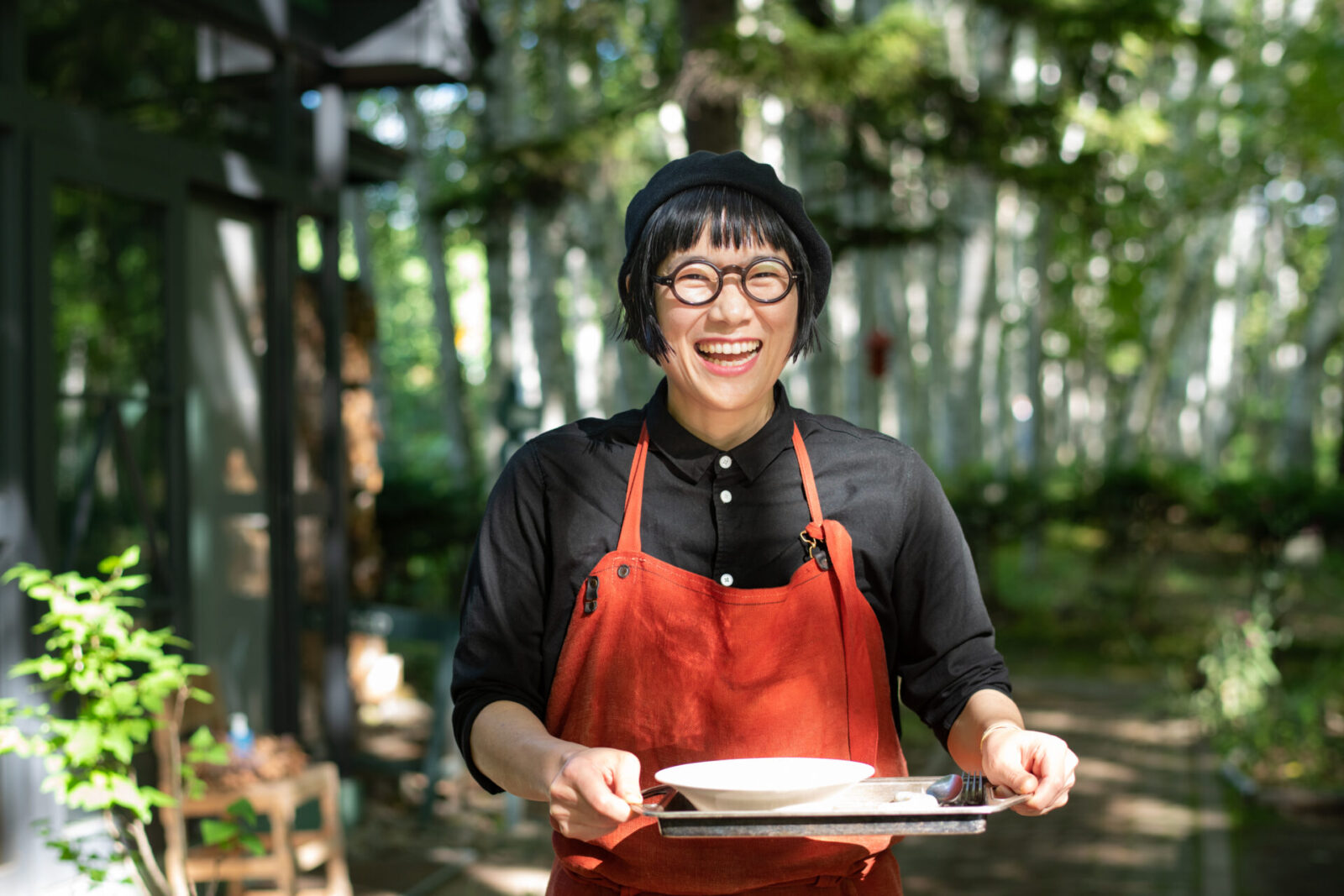
After tasting the melon and watermelon soup individually, I scooped a spoonful of both soups at once. It was a culinary experience unlike anything I had experienced before and it melted my heart.
Takahashi explained that she hopes her hillside soup will allow people to experience the scenery of Biei with all five of their senses.
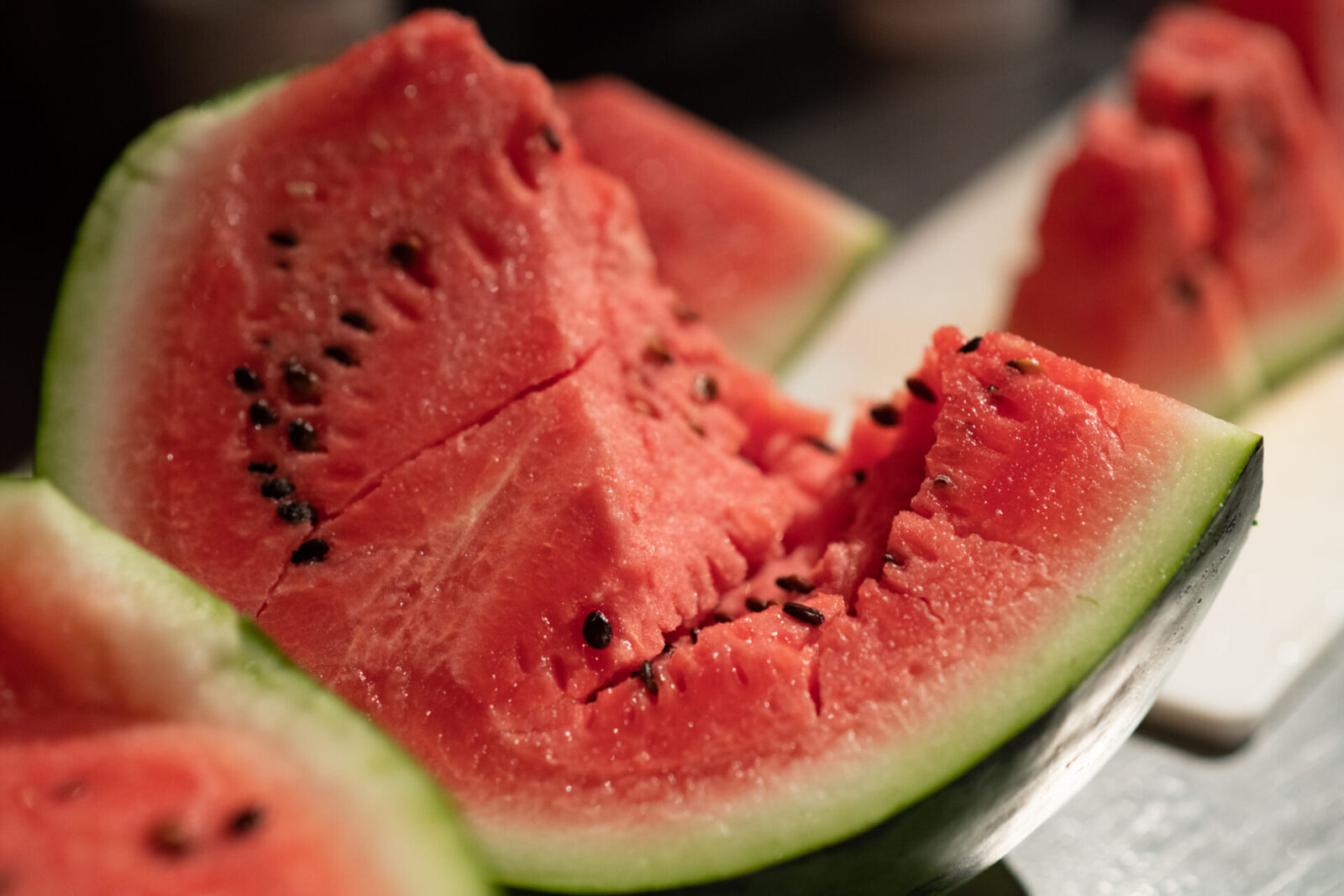
“The contrast in color between the sky and hills are incredibly beautiful in Biei. For me, eating the hillside soups are like consuming the scenery of Biei itself. The soup is inspired by the hills of Biei and I hope people will enjoy the seasonal ingredients and flavors of Biei while breathing in the scenery.”
There is a photo gallery called Takushinkan on the same premises as the restaurant, and it is part of the story of how this soup came to be.
Takahashi was born in Tokushima Prefecture, grew up in Hyogo Prefecture and spent many years working in Tokyo. She is the creator of the massively popular Egypt Jio (Egypt salt). We talked to her about her journey that led to her move to Biei, how the birth of hillside soups came to be and the reasons behind her desire to provide experiences that combine food and scenery.
Moving to Tokyo with dreams of becoming an interiors buyer
Takahashi grew up in a family of six, with an older brother and sister and a younger brother. In such a lively household, she says she started cooking as a way to get her parents’ attention.
Takahashi laughs as she says, “I was five years old when my little brother was born and I was upset that all of my parent’s attention was going to my brother. That was when my battle for attention began. I learned that cooking would win praise from my parents so I began cooking from around the time I was in second or third grade.”
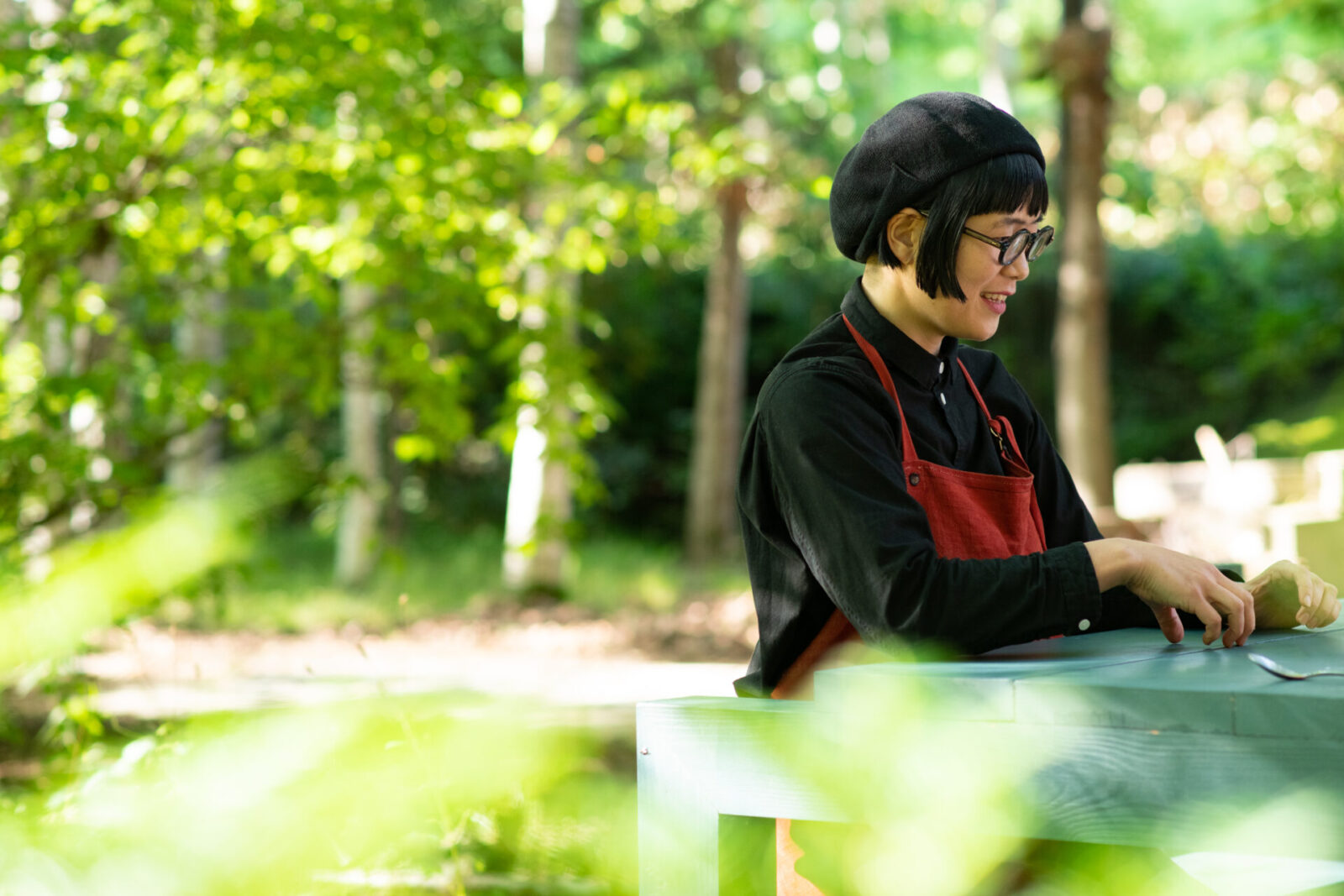
“I am pretty sure I made a mess in the kitchen, but my parents gave me the freedom to do as I pleased. When I was in fourth grade, cooking became especially fun as I was able to do a lot more on my own. My parents always enjoyed it and told me my food was delicious.”
When she entered middle school she began learning how to bake from her mother’s friend, and it sparked her interest in cooking even more. Cooking and baking became the “joy of her daily life” throughout her middle school and high school years.
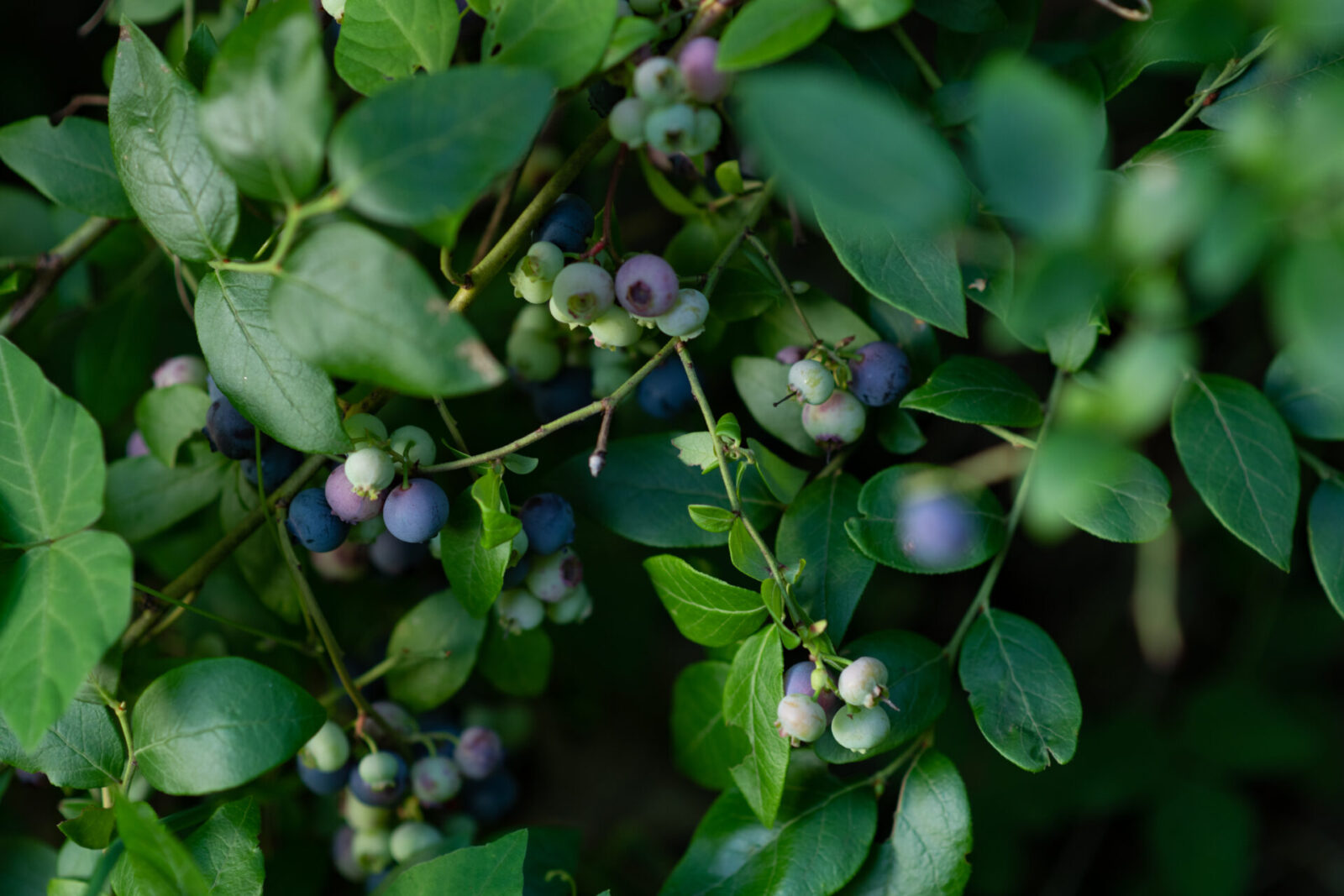
However, she never intended to pursue a career in cooking and it was purely a hobby.
There was an interior design shop in Ashiya City of Hyogo Prefecture called ACTUS. Ever since visiting the shop with her mother, she was in awe and would visit the shop regularly while dreaming of someday becoming a buyer of furniture from overseas.
After graduating high school in 1997, she moved to Tokyo and lived right behind the Aoyama Modern Age Gallery. Shinichiro Nakahara, who later established Landscape Products, a furniture manufacturing, sales, and space design company, was working at the gallery.
Takahashi knew about Nakahara through reading about him in magazines. One day she walked over to the gallery, and without making an appointment, directly handed Nakahara her resume.
This act worked in her favor. Nakahara told her, “You’re quite interesting. We’re about to start a new company so why don’t you help us out there,” and Takahashi got her start at her first shop at Landscape Products.
“Maybe that is your calling”
Due to some unfortunate circumstances, the first Landscape Products closed down shortly afterwards. Takahashi needed to find another job until the next shop would open.
By chance, she found a job at an Italian restaurant in Aoyama and she became excited about cooking again.
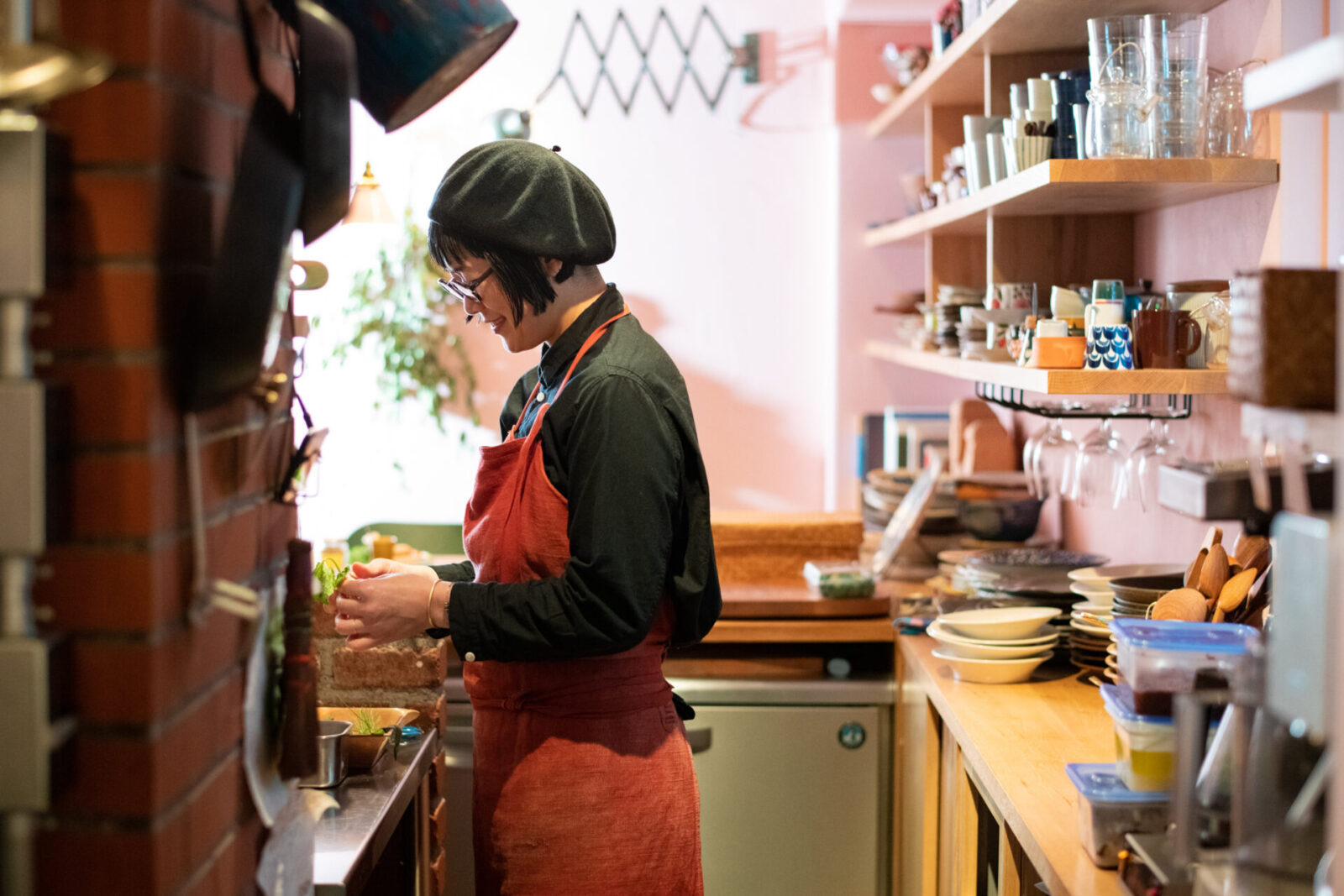
Soon after she started working at the restaurant, the chef quit so the four part time workers had to keep the restaurant running. Takahashi was put in charge of the kitchen.
Everyday she worked hard and cooked the dishes based on a recipe book left behind by the previous chef. The owner of the restaurant would come by occasionally, and although he would complain about the food, he allowed the four part time workers to continue the restaurant’s operations.
Takahashi felt a lot of pressure at first, but soon she began to enjoy the freedom she was given.
“I remembered how I felt cooking as a child, and it was really fun. I was always good at cooking with tomatoes so I felt confident in making tomato sauce. Although I only worked at that restaurant for half a year, I am still friends with my co-workers at the time.”
After Nakahara opened a new Landscape Products shop in Harajuku, Takahashi returned to work for him again. He told her that in order to work in the interior design industry, she should go train to improve her English and other necessary skills so she ended up transferring to a shop run by Nakahara’s friend.
However, this new workplace did not match well with her and she did not enjoy her job at all.
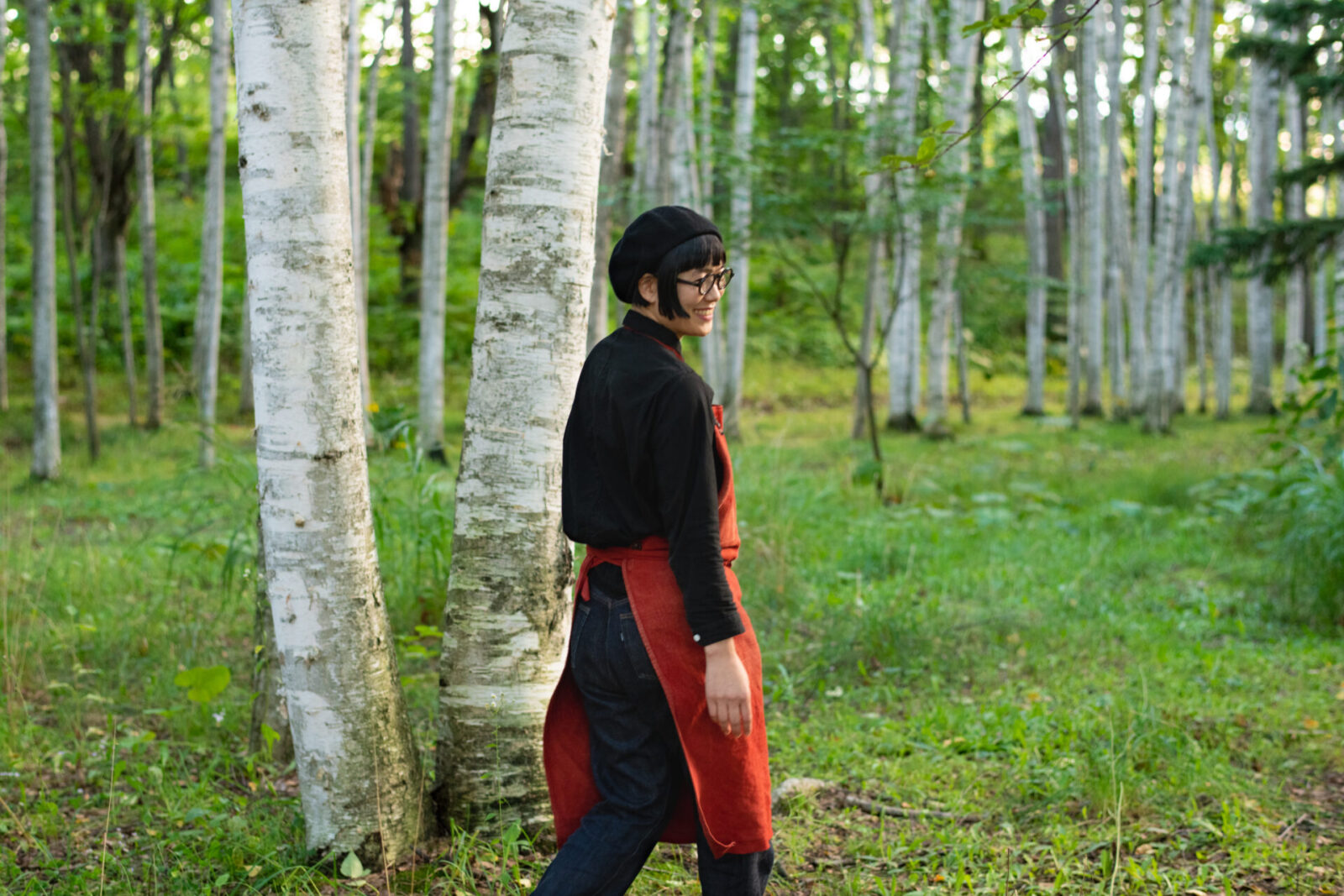
During this time, she often thought about her time working part time at the Italian restaurant, cooking foods that she was not accustomed to.
After two years of training, she wondered whether she wanted to continue working with Nakahara or if she should pursue a career in cooking. When she mentioned that she really enjoyed cooking to Nakahara, he told her, “Maybe that is your calling. Why don’t you pursue it?”
His advice instantly cleared her mind of doubt and she switched gears to pursue the world of cooking. Takahashi was 23 years old at the time.
A salt inspired by her sister’s travels
After making up her mind, Takahashi went on to work at restaurants in various cuisines, such as Italian, Indian and Japanese, to learn all she could about cooking. Unfortunately, the overwork eventually led to a back injury and she could no longer stand in the kitchen for long hours at a time.
Around that time, a culinary expert who she had met at her favorite ceramics shop invited her to work with her as an assistant. It was the first time Takahashi worked with a culinary expert and she absorbed everything she could from this experience.
A few years later, Takahashi started her own career as a culinary expert and she produced a product that launched her into fame. The product was the all purpose seasoning, Egypt Jio.
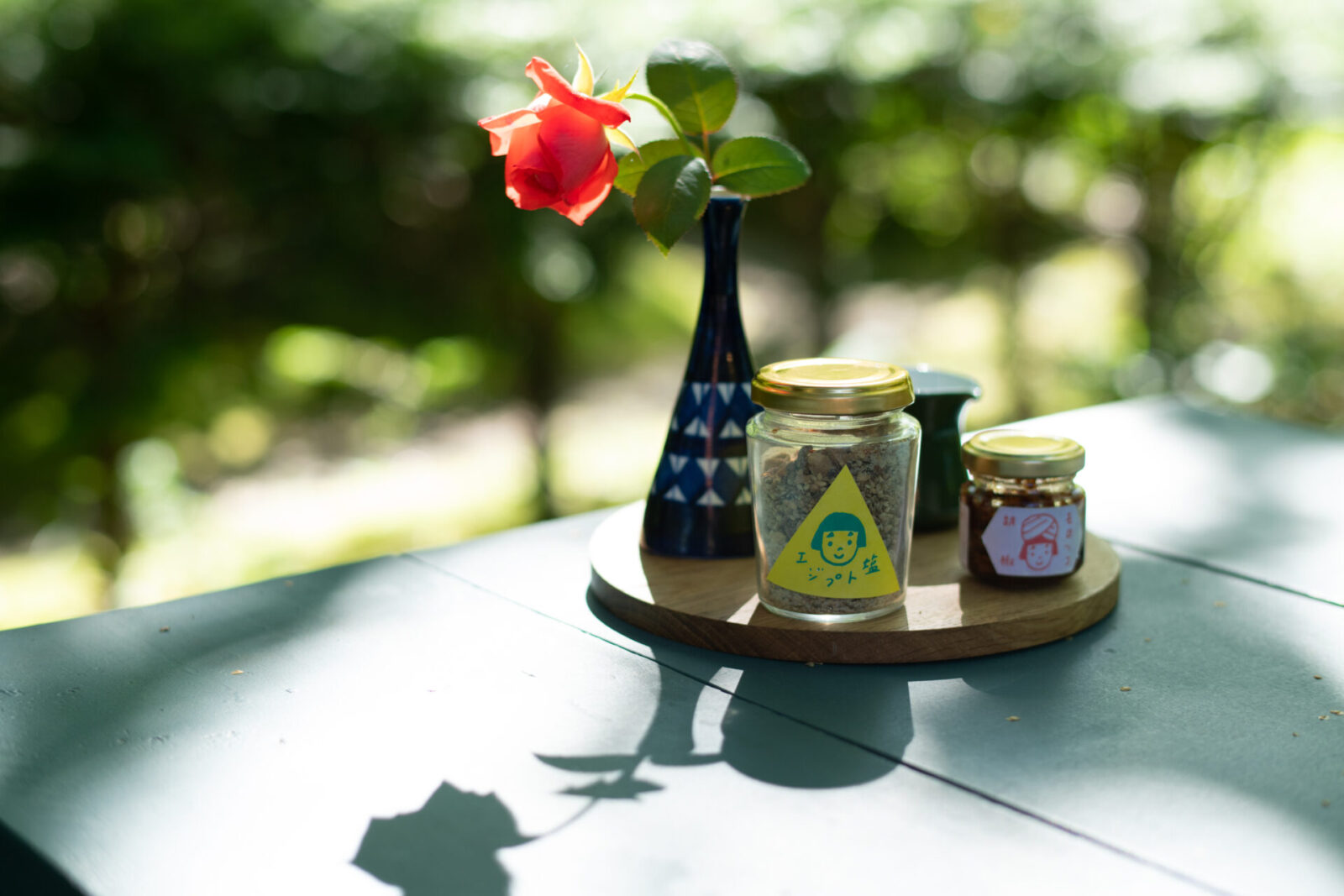
Egypt Jio is a hugely popular seasoning that is known to make meat and vegetable dishes instantly and vastly more flavorful and aromatic.
The creation of this product was based on an experience Takahashi’s sister had shared with her about her travels.
Takahashi became interested in salt after she started working professionally in food. She collected salts from around the world and tried blending them with different ingredients. It was during this time that she remembered a conversation she had with her sister, who she is very close to, a few years prior.
“When I was in highschool, my sister traveled to Egypt for about three months. When she returned she told me about how there are many interesting spices in Egypt with wonderful aromas. When I remembered this, I tried experimenting by adding cumin, coriander, almonds and white sesame seeds to salt.”
Takahashi herself had never been to Egypt, so she named the salt “Egypt Jio” with the intention of expressing the product as “a salt that takes you on a trip to Egypt.”
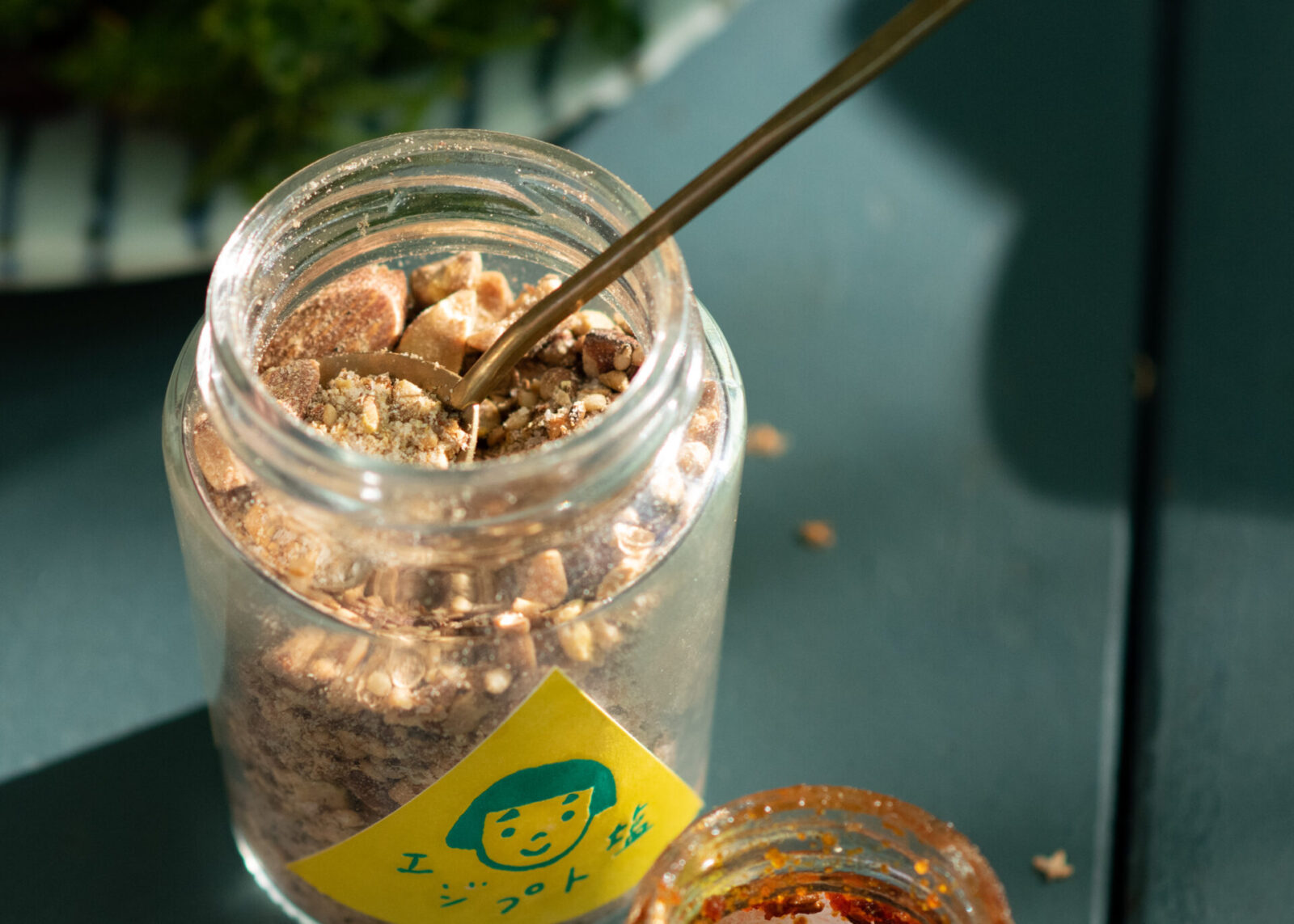
One day, Takahashi made a dish using Egypt Jio for a photoshoot of a magazine that introduced recipes in a regular series. The dish received unexpectedly high praise and the magazine decided to do a special series focusing on the product.
Takahashi had been making the blends to use for her own cooking, so had no initial intention of turning it into a commercial product.
It was an unexpected turn of events for Takahashi, but after the special series called “Experimenting with Egypt Jio” came out in October 2010, she was faced with an even more surprising development.
The readers of the series were so intrigued that the magazine received countless letters and emails inquiring about the product.
How Egypt Jio grew to thousands of monthly sales
Receiving all this positive feedback encouraged Takahashi to turn Egypt Jio into a commercial product.
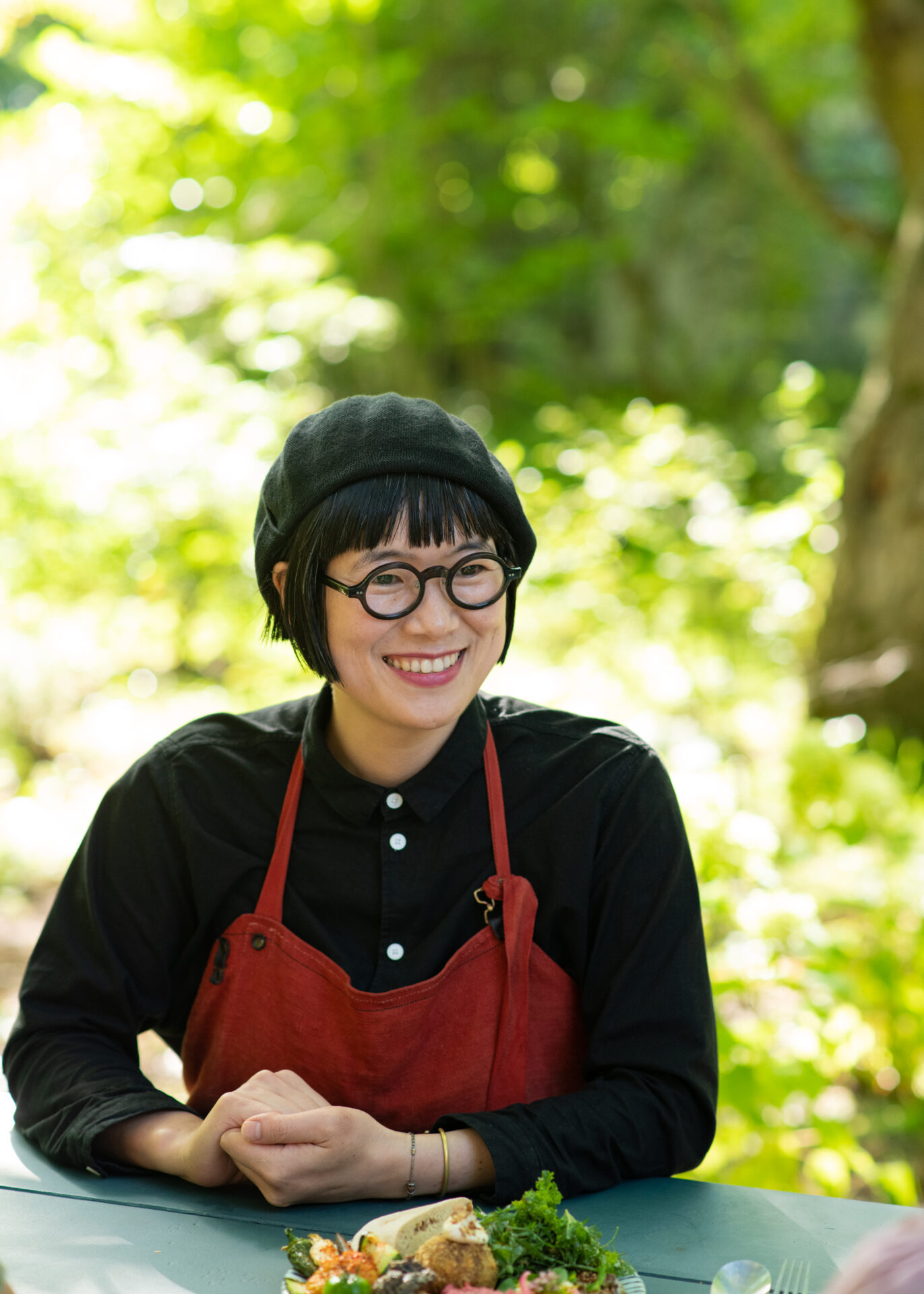
The yellow label with an illustration of a girl with cropped bangs was designed by Takahashi’s husband, Kei Maeda, who is an art director and photographer. The two worked together for six months to come up with the design.
“I asked him not to put my face on the label, but he didn’t listen. He convinced me that just as farmers put their pictures on their produce at farmer’s markets, having the face of the maker will help build trust with the consumers. We debated between putting an illustration or an actual photo, and I refused to allow the photo so we settled on the illustration.”
In 2012 Takahashi obtained a license to manufacture seasonings and rented a property in Nishi Koyama of Tokyo. Here, she started a restaurant and the Egypt Jio processing factory.
Her first batch was 600 jars. In order to make it even more delicious, she added pistachios in her next batch.
Pistachios cost five times more than almonds, so the cost of raw ingredients skyrocketed. Nonetheless, she wanted her customers to enjoy the flavor and spread happiness, so she accepted the high cost.
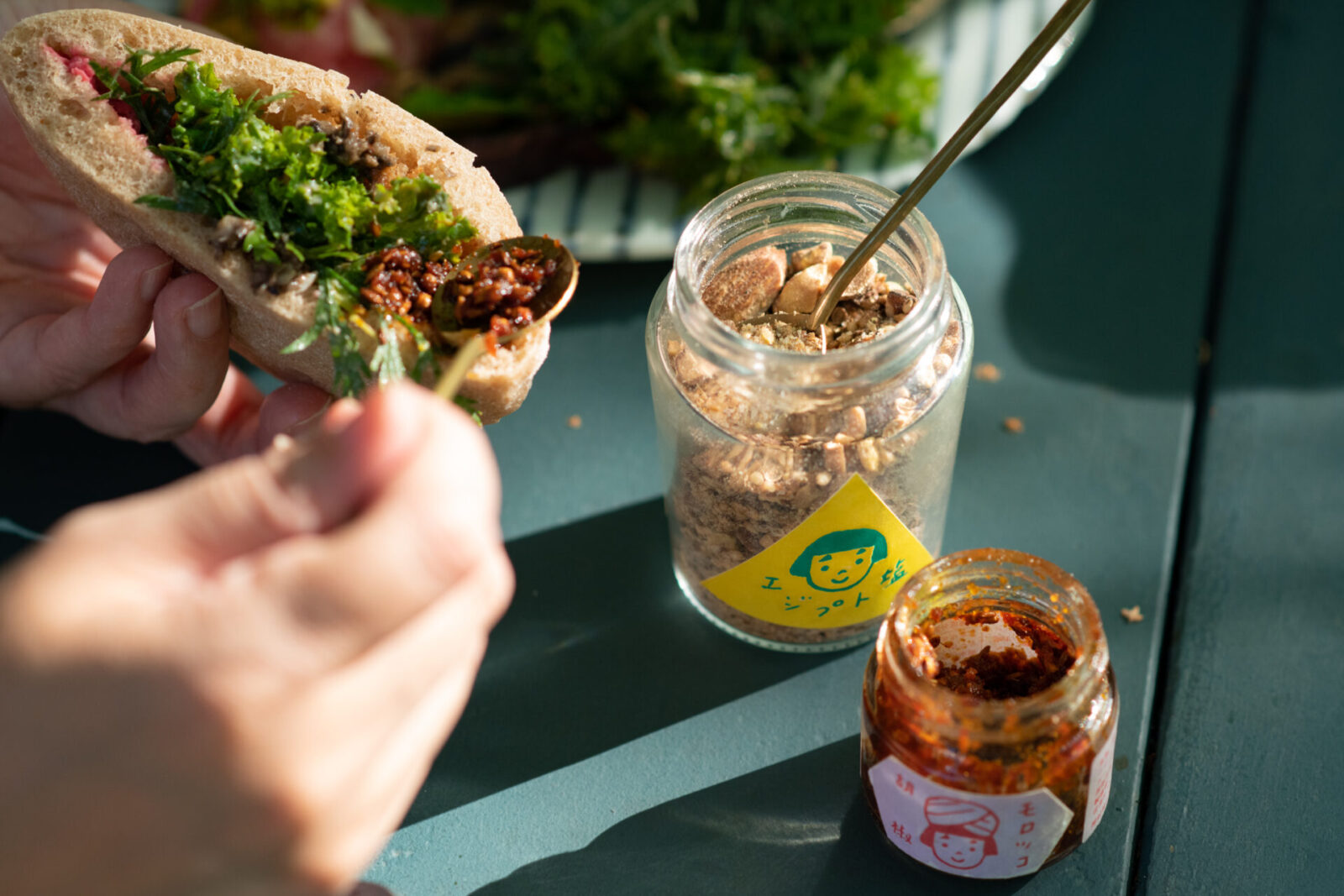
The next batch of 400 jars was scheduled to be sold at the Momiji-ichi market on the banks of the Tama River. However, the market was canceled due to heavy rain and Takahashi was left with a large inventory.
Through the help of the online store of the magazine that initially introduced her product and friends who owned shops, she was somehow able to sell all of her inventory, but this experience made her vow to never make the product again.
Contrary to her vow, she received endless inquiries from people who wanted to buy her product again.
Reluctantly, she started production up again and the product’s popularity continued to spread by word of mouth. It was taken up by media outlets which drew even more attention, and her customers kept coming back for more, all the while creating a positive business cycle.
Before she knew it, her name Yoshiko Takahashi became recognized as the culinary expert who created the Egypt Jio. The product continued to grow in popularity and now they sell over 2000 jars a month.
Photographer Shinzo Maeda and Takushinkan
With the success of her Egypt Jio products, Takahashi continued to expand her business and in 2020, she and her family moved to Biei.
Takahashi’s husband Kei Maeda is the grandson of the famous photographer Shinzo Maeda. Shinzo Maeda was known for depicting the beauty of the Biei hills and photographed and exhibited his shots of Biei throughout his life.
Because of Shinzo’s work, Biei became known as the “town of hills.”
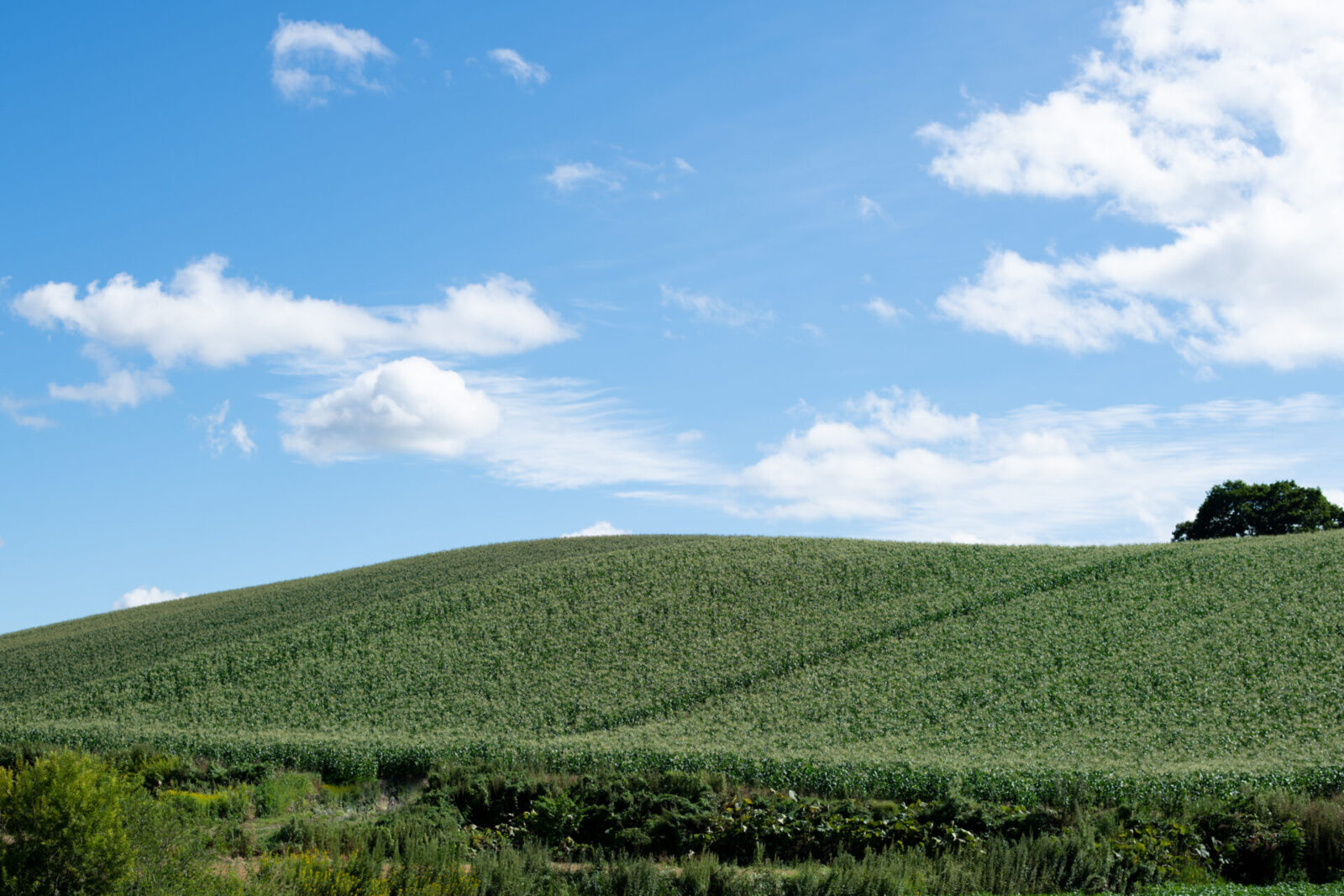
Shinzo Maeda bought a large 10 thousand square meter plot of land of a closed down elementary school in 1987, and renovated the gymnasium to create his own photo gallery called the Takushinkan. He also coordinated with the town of Biei to plant approximately 2,500 white birches to create beautiful landscapes in the region.

Although Takushinkan continued its operations after Shinzo’s passing in 1998, it faced financial difficulties.
Takushinkan had always operated without an entrance fee, and the only monetary gain was from the sales of photo collection books and postcards. Because there were basic operational costs, Takushinkan was running in the red for some time.
Kei’s father was considering shutting Takushinkan down. However, Kei had a strong attachment to Takushinkan and the surrounding white birch forests, so he opposed letting it go.
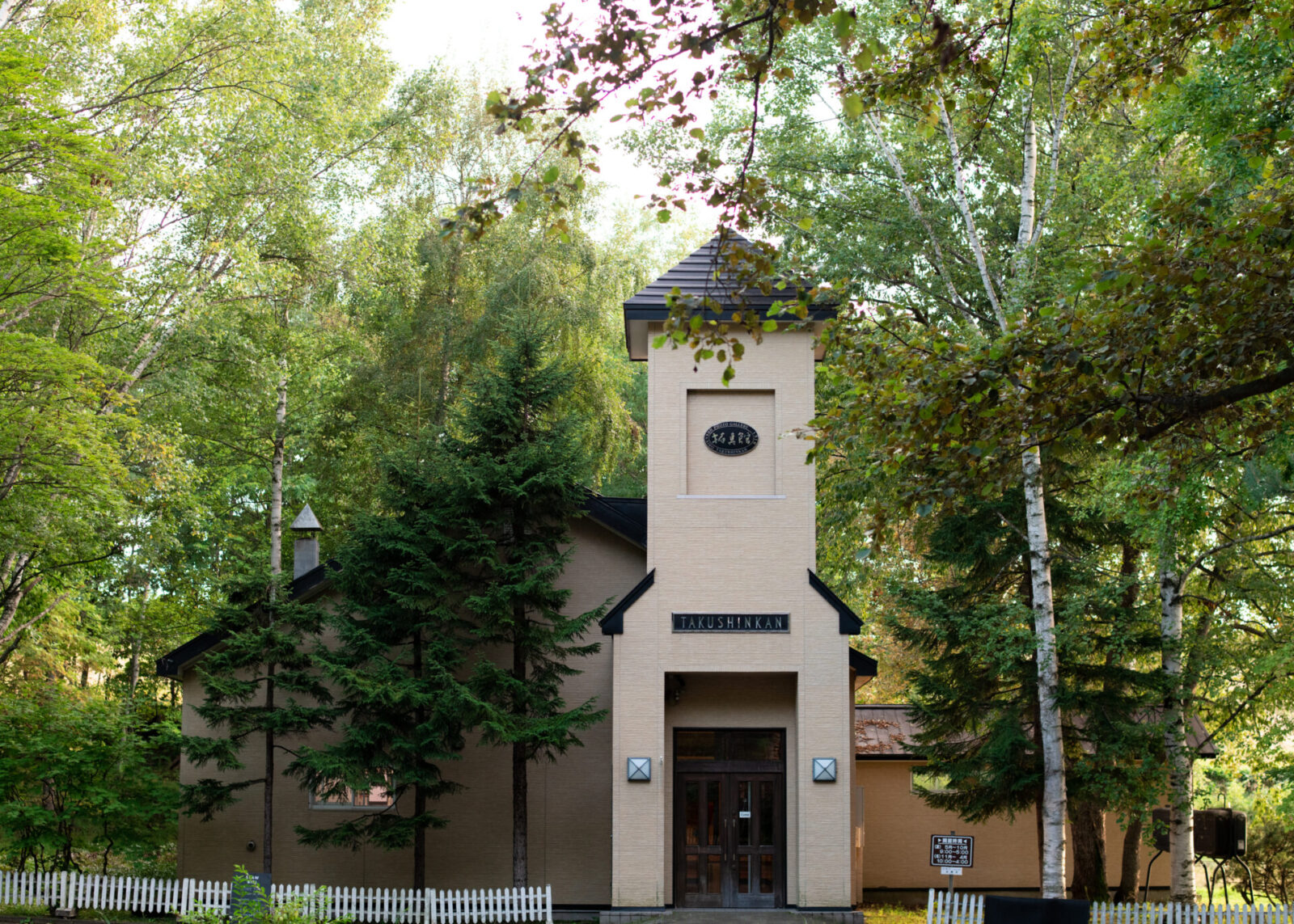
Takahashi and Kei held their wedding ceremony in Takushinkan in 2010. At the time, Kei said, “We need to do something to preserve this place. Maybe you can open a restaurant here someday.” Takahashi answered, “Yes, someday.”
Takahashi shared Kei’s love for the Takushinkan and the white birch tree forests even before they married. On the day of her wedding, she remembers thinking that she would like to open a restaurant in that forest one day.
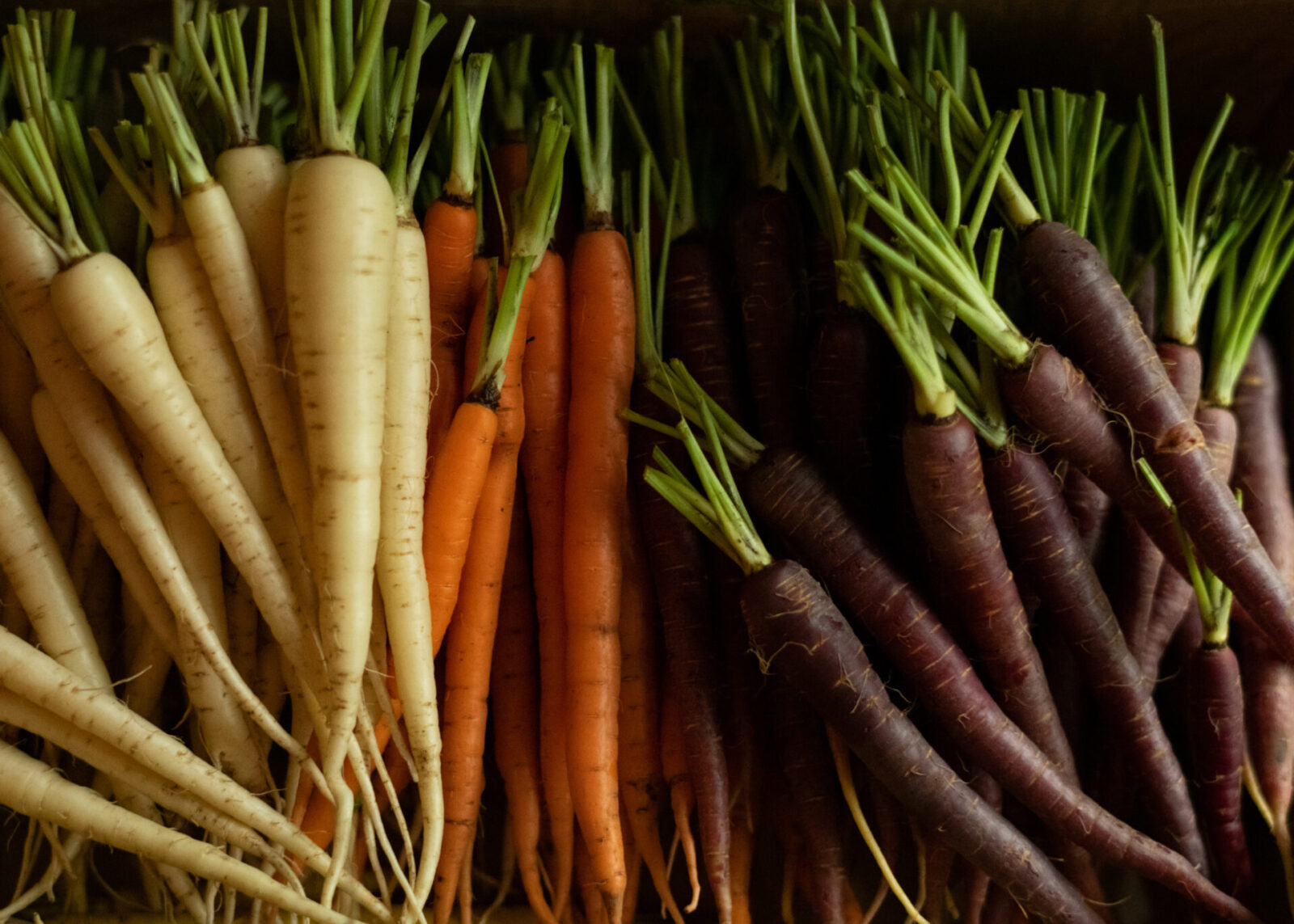
Relocating during the pandemic and an unexpected halt
Several years after their wedding, Kei began helping his parents’ company and learned that the burden of keeping Takushinkan operating was bigger than he had imagined. As the eldest son, Kei decided to take on the family business in 2018, and Takahashi looked forward to moving to Biei.
“Over the last ten years I had more opportunities to work in rural areas through cooking classes and catering events, and I met a lot of people who are living fruitful lives in the countryside. Until then, I always thought everything was centered in Tokyo, but I started to dream about living a fulfilling life in the countryside while doing a job I love.”

The question was where to open a restaurant.
Their original plan was to build a new building on the property, but they found that their budget did not suffice. They reluctantly chose the option that was their last resort, which was to renovate a former staff housing building of the old elementary school.
The building had been abandoned since 1998, but Takahashi and Kei were determined to realize their vision so they started renovation. They removed everything from the building except the wood stove and slowly began building their restaurant.
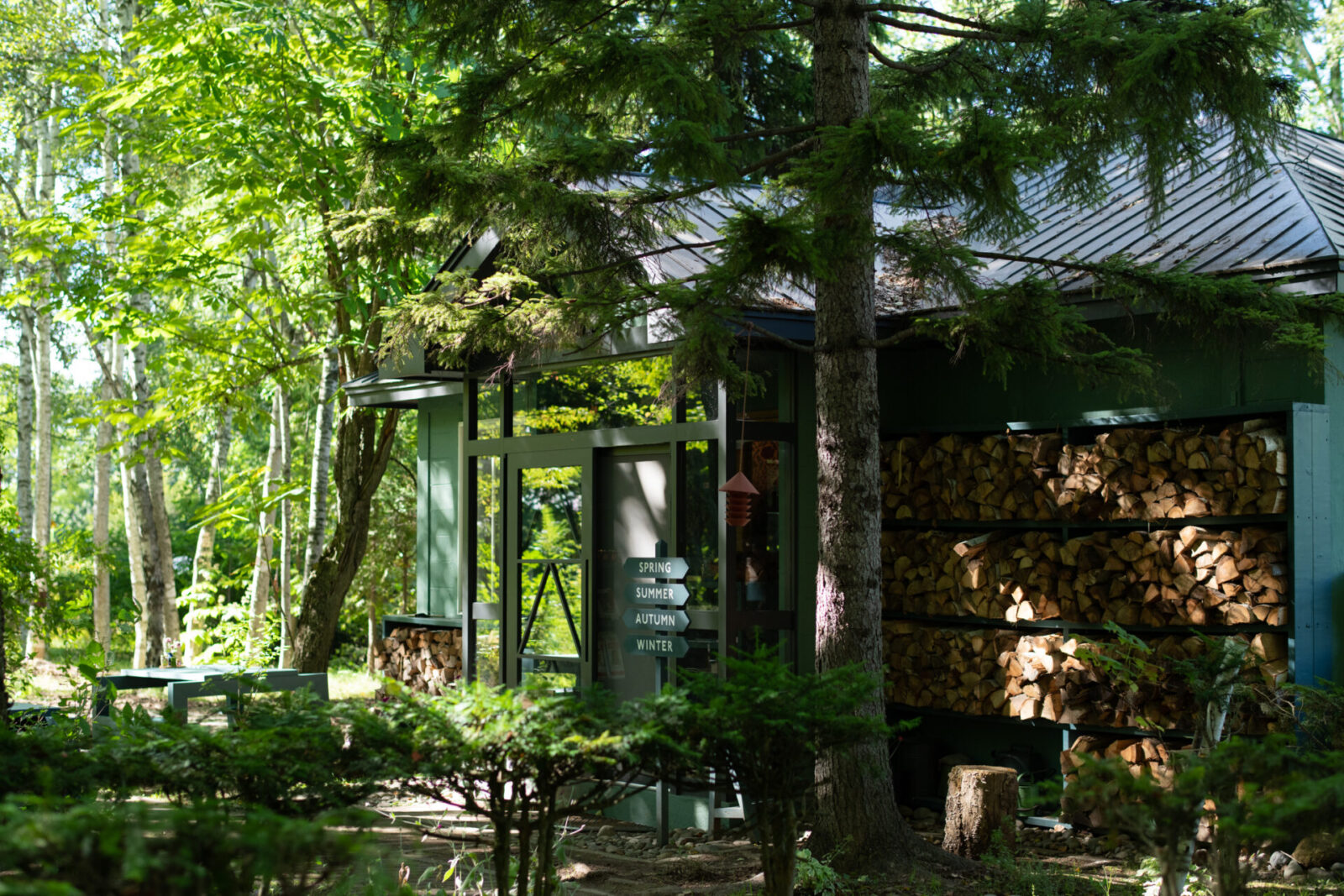
In the midst of the coronavirus pandemic, they moved in the spring of 2020 with some uncertainty.
Although they had planned to open their restaurant right away, it was delayed. The days in which Takushinkan had absolutely no visitors continued and they became worried about the prospects of their future here.
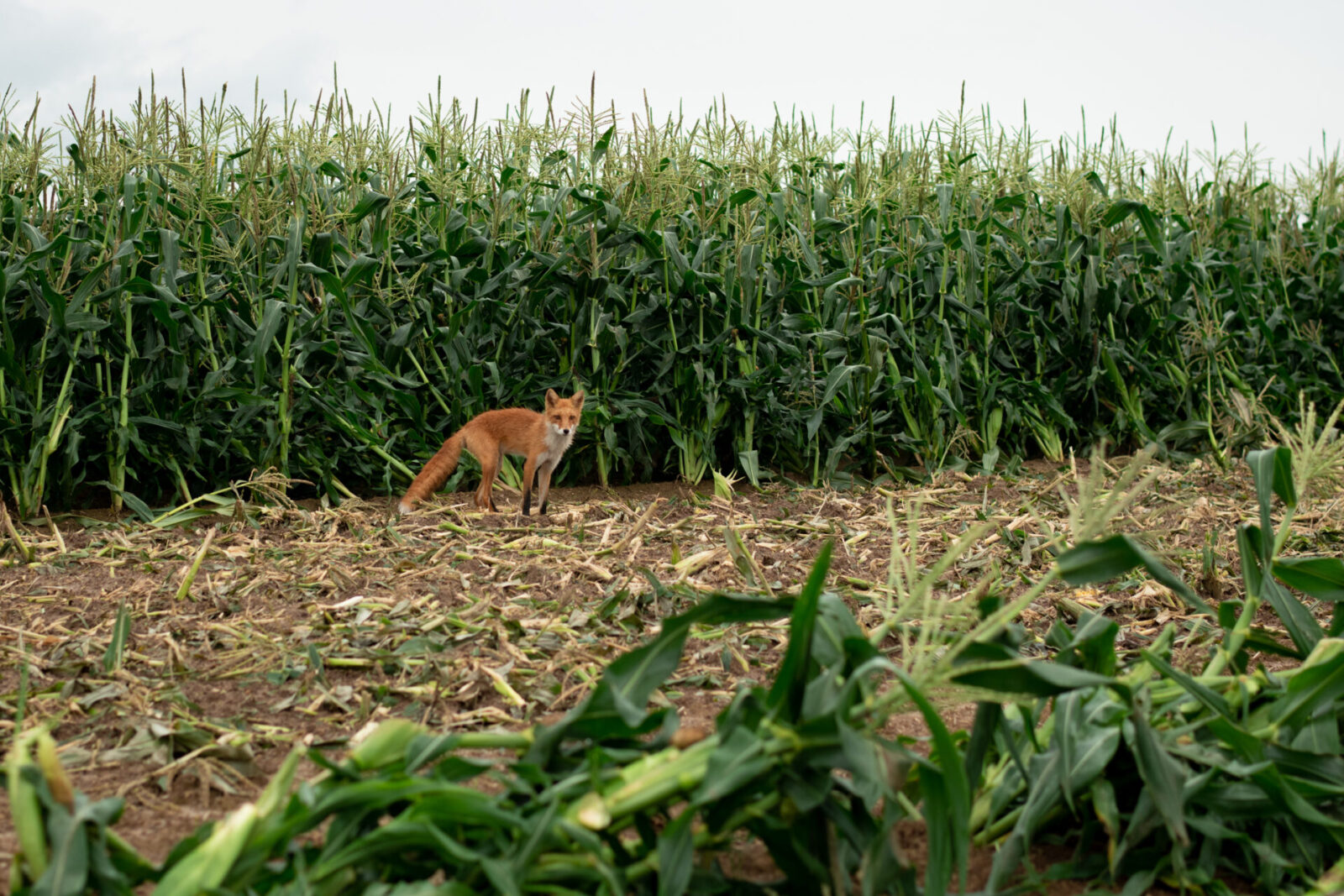
How the “hillside soup” came to be
Ultimately, they were forced to take a break for a year and a half, but they were able to open their restaurant in September 2021. Takahashi says, “Thinking back on it now, it was a wonderful break.”

“Because we had time, we were able to introduce ourselves to the local people and tell them about the restaurant we were starting. I went to visit the farmers I worked with at my wedding and they introduced me to other farmers. I was able to learn what kind of ingredients are available locally and got to know the people better.”
“When the pandemic began to calm down, my friends visited me so I was able to cook them dishes using the local ingredients and ask for their feedback. In retrospect, it was a good thing that we didn’t open the restaurant right away.
It was during this break that Takahashi created the “hillside soup.”
When Kei saw the colorful pottage soups made from the local Biei ingredients, he asked Takahashi to try to make a soup with two colors. When she made the prototype, they loved it and their staff also shared their excitement with how beautiful and appealing it was.
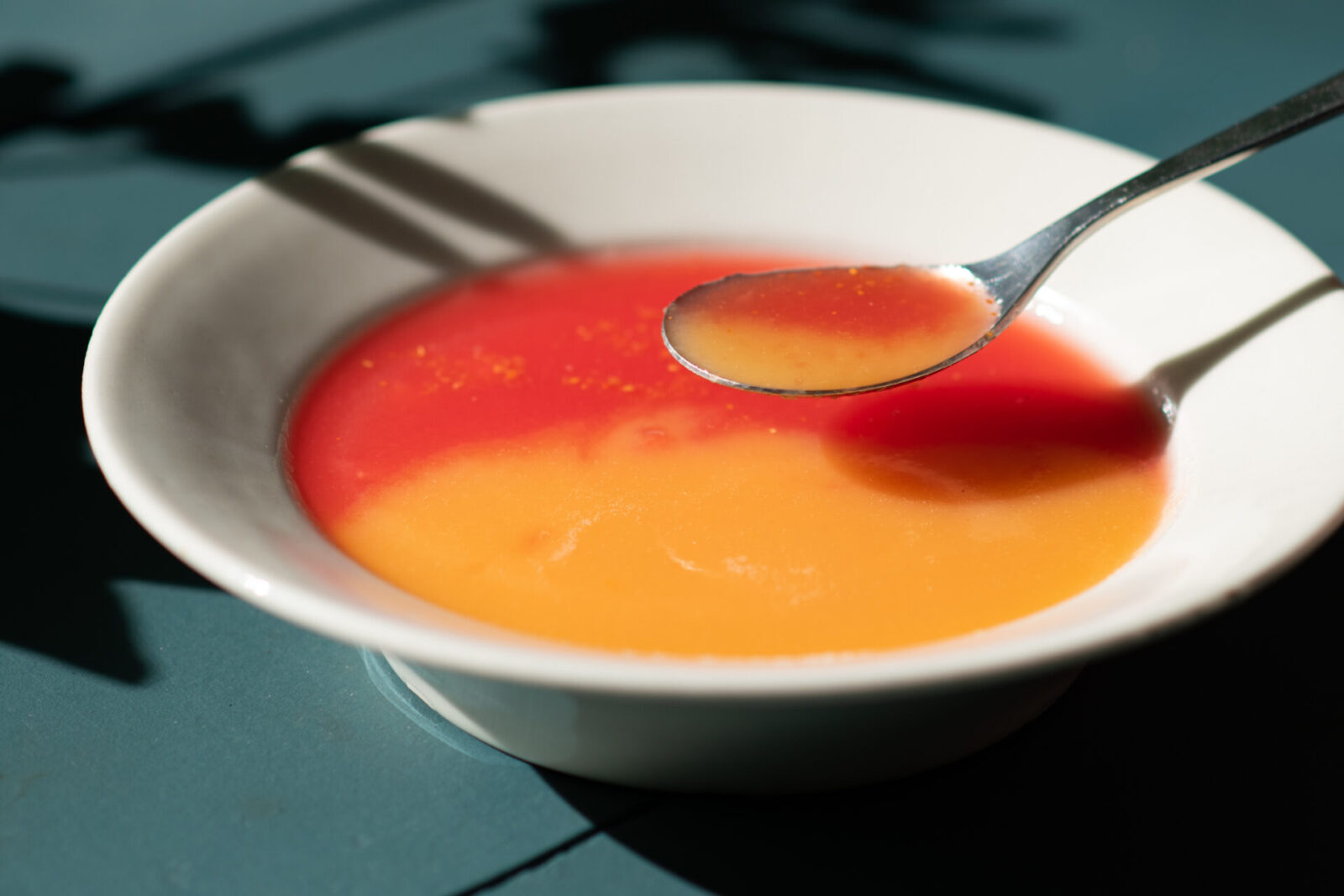
This soup is actually not an easy food to handle. Heating the pottage directly can easily cause it to burn. Even a slight burn changes the flavor of the soup, so the soup needs to be heated over steam, and that takes much longer.
It also takes up two of their kitchen burners so it slows down the cooking of other dishes. Once the restaurant started running, Takahashi realized how difficult it was to put this dish into operation.
Nonetheless, she continued to serve the hillside soup.
The reason for this is because the soup is a tribute to Shinzo Maeda.
“Shinzo’s simple act of taking photographs of the Biei scenery made this town famous. My husband said that he wants me to use as many delicious local ingredients as possible and promote the region through both food and scenery. This sentiment resonated with me.”
We tasted the hillside soup that was served to us that day.
The melon pottage had a hint of chamomile and a refreshing sweetness. It was a delicate soup that eases your mind and body. The watermelon pottage with red peppers was juicy but had a spicy kick to it. When tasting the two soups together, the uniqueness of each soup expands in your mouth like fireworks and disappears while leaving a rich aftertaste.
In the forest, the most relaxing place
SSAW BIEI is now open from 10 a.m. to 5 p.m. They serve one plate meals and the hillside soup. When we visited, the store was packed even though it was a weekday.
The one plate meals are also an expression of Takahashi’s relations with the local farmers.
For example, on the day we visited we were served ancient wheat grown in Furano, kale grown by a farmer in Biei, corn, beets, white carrots, purple carrots, zucchini, baby peppers, and joue de bebe tomatoes; everything but the Egyptian salt ingredients were produced in Hokkaido.

Naturally, all of the ingredients are of exceptional quality and grown with care by the farmers. We filled the pita made with the ancient wheat with the abundant vegetables and took a bite. It was a luxurious ensemble of umami flavors and made us let out a sigh of satisfaction.
When the interview was nearing its end, we took a walk through the forest with Takahashi. In the forest, there were a few varieties of mushrooms. Takahashi picked them while saying, “I feel the most relaxed when I am walking through this forest.”

“Even though we moved to Hokkaido, we still haven’t visited any of the local attractions. There are a lot of places I want to go, like Nemuro and Shiretoko, but I haven’t been anywhere yet. I wondered why that is and realized that we simply really really love where we are and are so happy here.”
“We find mushrooms, wild forage and nuts just by taking a short walk through the forest. There is an excitement here that cannot be experienced in Tokyo. If I ever feel gloomy in the house, I just walk out here and my feelings are uplifted. The winters are cold but beautiful and everything is so pleasant.”
Takahashi continues to make her hillside soups while breathing in the delicious air of the Biei hills.
Photo: Yuko Kawashima
Translation: Sophia Swanson
Editor. Born and raised in Kagoshima, the birthplace of Japanese tea. Worked for Impress, Inc. and Huffington Post Japan and has been involved in the launch and management of media after becoming independent. Does editing, writing, and content planning/production.
